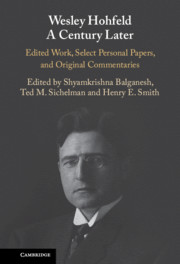21 results
Part III - Hohfeld and Equity
-
- Book:
- Wesley Hohfeld A Century Later
- Published online:
- 14 July 2022
- Print publication:
- 28 July 2022, pp 293-342
-
- Chapter
- Export citation
11 - Very Tight “Bundles of Sticks”: Hohfeld’s Complex Jural Relations
- from Part IV - Hohfeldian Complexities
-
-
- Book:
- Wesley Hohfeld A Century Later
- Published online:
- 14 July 2022
- Print publication:
- 28 July 2022, pp 345-365
-
- Chapter
- Export citation
Tables
-
- Book:
- Wesley Hohfeld A Century Later
- Published online:
- 14 July 2022
- Print publication:
- 28 July 2022, pp ix-ix
-
- Chapter
- Export citation
Part IV - Hohfeldian Complexities
-
- Book:
- Wesley Hohfeld A Century Later
- Published online:
- 14 July 2022
- Print publication:
- 28 July 2022, pp 343-438
-
- Chapter
- Export citation
Contributors
-
- Book:
- Wesley Hohfeld A Century Later
- Published online:
- 14 July 2022
- Print publication:
- 28 July 2022, pp x-xx
-
- Chapter
- Export citation
Some Fundamental Legal Conceptions as Applied in Judicial Reasoning
-
-
- Book:
- Wesley Hohfeld A Century Later
- Published online:
- 14 July 2022
- Print publication:
- 28 July 2022, pp 15-70
-
- Chapter
- Export citation
Part V - Hohfeld and Society
-
- Book:
- Wesley Hohfeld A Century Later
- Published online:
- 14 July 2022
- Print publication:
- 28 July 2022, pp 439-517
-
- Chapter
- Export citation
Part I - Philosophy of Jural Relations
-
- Book:
- Wesley Hohfeld A Century Later
- Published online:
- 14 July 2022
- Print publication:
- 28 July 2022, pp 97-220
-
- Chapter
- Export citation
Figures
-
- Book:
- Wesley Hohfeld A Century Later
- Published online:
- 14 July 2022
- Print publication:
- 28 July 2022, pp viii-viii
-
- Chapter
- Export citation
Copyright page
-
- Book:
- Wesley Hohfeld A Century Later
- Published online:
- 14 July 2022
- Print publication:
- 28 July 2022, pp iv-iv
-
- Chapter
- Export citation
Introduction: Hohfeld at the Crossroads
-
-
- Book:
- Wesley Hohfeld A Century Later
- Published online:
- 14 July 2022
- Print publication:
- 28 July 2022, pp 1-14
-
- Chapter
- Export citation
Contents
-
- Book:
- Wesley Hohfeld A Century Later
- Published online:
- 14 July 2022
- Print publication:
- 28 July 2022, pp v-vii
-
- Chapter
- Export citation
Part II - Hohfeld and Property
-
- Book:
- Wesley Hohfeld A Century Later
- Published online:
- 14 July 2022
- Print publication:
- 28 July 2022, pp 221-292
-
- Chapter
- Export citation
Selected Personal Papers of Wesley Newcomb Hohfeld
-
-
- Book:
- Wesley Hohfeld A Century Later
- Published online:
- 14 July 2022
- Print publication:
- 28 July 2022, pp 71-96
-
- Chapter
- Export citation
Index
-
- Book:
- Wesley Hohfeld A Century Later
- Published online:
- 14 July 2022
- Print publication:
- 28 July 2022, pp 518-532
-
- Chapter
- Export citation

Wesley Hohfeld A Century Later
- Edited Work, Select Personal Papers, and Original Commentaries
-
- Published online:
- 14 July 2022
- Print publication:
- 28 July 2022
22 - The Pathologies of Data-Generating Patents
- from Part VII - Intellectual Property Rights for Health Big Data
-
-
- Book:
- Big Data, Health Law, and Bioethics
- Published online:
- 26 February 2018
- Print publication:
- 08 March 2018, pp 324-336
-
- Chapter
- Export citation
Contributors
-
-
- Book:
- Perspectives on Patentable Subject Matter
- Published online:
- 05 December 2014
- Print publication:
- 28 November 2014, pp vii-viii
-
- Chapter
- Export citation
10 - The Vonage Trilogy
-
-
- Book:
- Perspectives on Patentable Subject Matter
- Published online:
- 05 December 2014
- Print publication:
- 28 November 2014, pp 313-335
-
- Chapter
- Export citation
Contributors
-
-
- Book:
- Intellectual Property at the Edge
- Published online:
- 05 May 2014
- Print publication:
- 19 June 2014, pp x-xvi
-
- Chapter
- Export citation



